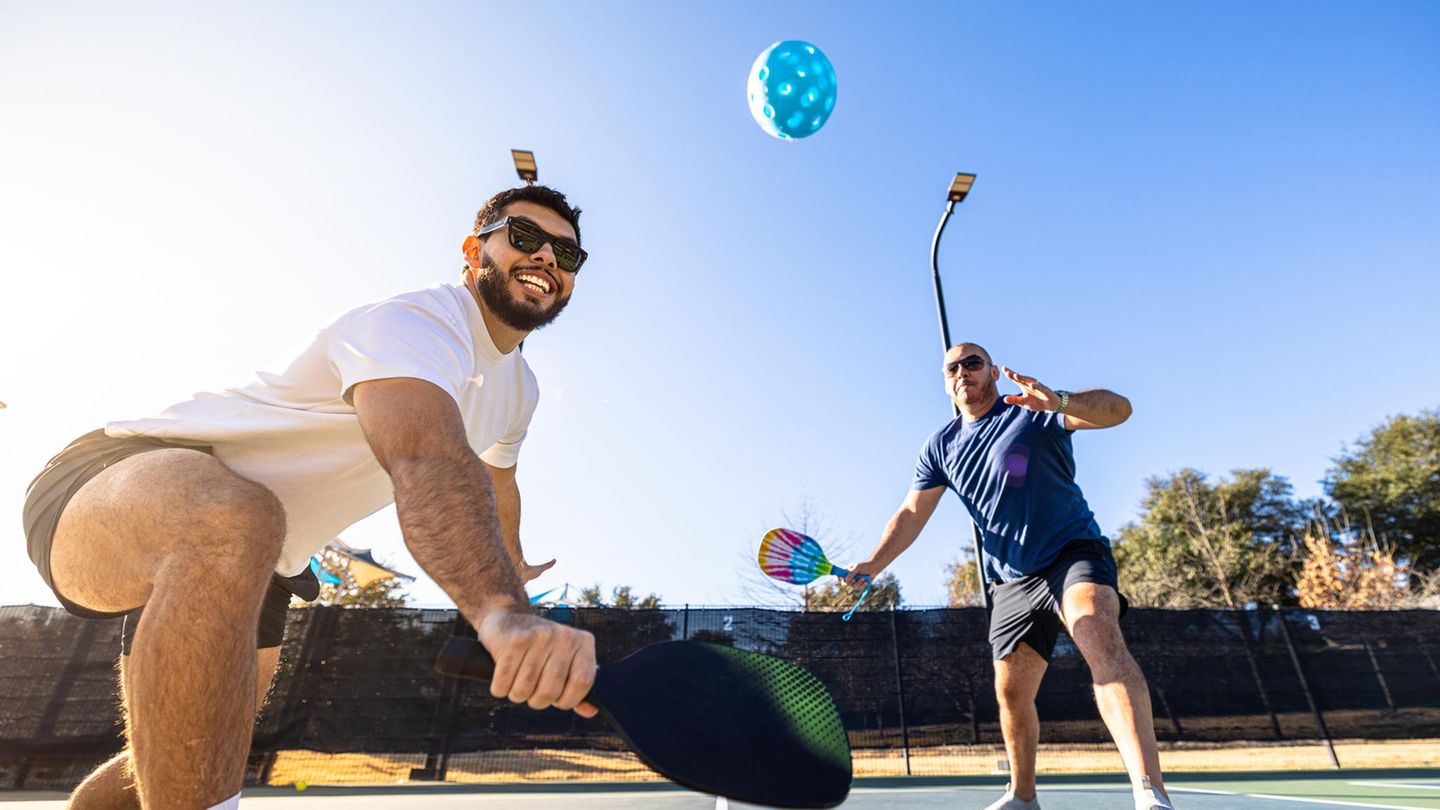Racking
Pickleball conquers Germany: This is how the entry into trend sports succeeds
A mix of tennis, table tennis and badminton sounds exciting and it is too. This is exactly why Pickleball attracts beginners like professionals – and brings people together on the pitch.
It starts with a typical sound: a short, hard “clack” that comes from the impact of a perforated plastic ball onto a racket. Then a quick step forward, a setback, again a “crack” – and laughter. If you happen to come across a group of people on an urban sports field or in the park, who laugh with a ball, playing small fields on asphalt or gyms and swinging strangely compact rackets, probably has to do with pickleball. The sport with the curious name is booming – not only in the United States, where it has long since become a leisure movement, but also increasingly in Germany.
The game is hardly noticeable that pickleball has its roots in the 1960s. It looks young, accessible, quickly, but not overwhelming – and it brings people together who otherwise rarely share common forms of movement: young people with retirees, office workers with recreational athletes, beginners with ambitious. Pickleball has neither the complicated rules of tennis nor the pace of Squash or the depth of frustration that some experience in table tennis.
Instead, a game is created on a few square meters that works immediately, costs little, physically demanding, but rarely overwhelming – and in which game intelligence counts as much as technology or speed. The attraction is also in the rhythm: the rallies are often short, the game can be learned in a few minutes, and since there are usually four players in a small space, there are many encounters, looks, comments – and thus something that is often missing in other sports: communication. Pickleball, you notice that quickly, is a social sport.
Pickleball – what is it about?
At first glance, the field is similar to a badminton field and is significantly smaller than a tennis court. Two to four people face each other, mostly in doubles, and beat a ball that looks like an oversized table tennis ball with holes, over a low network. The racket – called paddle – is larger than a table tennis racket, but more compact than a tennis racket. Not to be confused with paddle tennis (also known as a padel). Here, players struggle with walls on a larger playing field by trying to play with a printed tennis ball and perforated rackets-the way of playing is strongly reminiscent of double tennis, but with band use.
In the case of pimple ball, on the other hand, a negotiation is played, and there is a so -called “kitchen zone” directly on the network, which you should not jump into, which makes aggressive smashs difficult. All of this also makes the game attractive for people who do not want to rely on sprint or power, but on technology, playing joke and timing. Coupled with a high level of fairness and uncomplicated rules, such a game that works in schoolyards as well as in rehabilitation clinics, on sports fields as well as in senior residences.
Incidentally, the name “Pickleball” has an unusual but charming origin: In the early years of the game, which was invented on Bainbridge Island by three fathers to maintain their children in 1965, there was initially no official name. It was only later at the suggestion of Joan Pritchard, the wife of Miterfinder Joel Pritchard, was baptized after the so -called “Pickle Boat”. This means a boat in English, in which the rower that was not selected for the regular competitions – a kind of reserved reserve crew. The choice of names was meant with a wink and alludes to the improvised, hybrid nature of the game, which combines elements of tennis, badminton and table tennis-a sporty “cucumber troop boat”, which nevertheless made it great popularity.
What equipment do you need for pickle ball?
Pickleball lives from its low threshold – and that is exactly why it is worth taking a closer look at a few aspects of the equipment. The most important component is the paddle, i.e. the racket. While simple models made of wood are often used in schools or leisure facilities, more ambitious beginners use: inside often to paddles from composite materials such as graphite or carbon fibers. These not only offer a better feeling of the ball, but are also much easier, which particularly makes longer games or people with sensitive wrists more pleasant.
Such a paddle, as the model of the table tennis already known convinced with good grip, balanced weight distribution and is delivered including a carrying bag – which pays off when playing outdoors. If you prefer to play in the hall, pay attention to paddles with a non -slip handle coating and a slightly increased shock, such as that can be found in Niupipo products.
There are also differences in the ball: For outdoor games, you need so-called outdoor balls with smaller and more numerous holes that are less susceptible to wind. Indoor balls, on the other hand, have larger holes and are a little softer, which makes the impact on the indoor floor more pleasant. Brands like offer both variants in tournament quality.
For the game in pairs or in groups, a portable mains solution is often sufficient, which can be built up in a few minutes. If you want to play permanently in the courtyard or garden, you can find mobile at Amazon that stand stable, are adjustable in height and have a robust fiberglass construction. They are delivered with weatherproof bag.
Last but not least, it is worth taking a look at footwear. While pickle ball is more gentle on the joint than many other checking sports, but if you play on a gripy surface, you should choose indoor sports shoes with an abrasion -resistant sole. Models like the or the offer sufficient side stop and good damping without restricting mobility. Light tennis shoes with a solid sole are suitable for external use on asphalt, as they are at or are available.
Why pickleball is more than a trend sport
While own halls are already being built in the United States and celebrities such as Leonardo DiCaprio or the Kardashians discovered the game for themselves, the German scene develops a little more carefully. In many cities, the first courts are created in parks, often improvised with chalk and mobile networks. Municipalities begin to release existing tennis or basketball fields for pickleball. If you are thinking about trying out the sport, you will already find groups via platforms such as “Meetup” or local sports clubs that establish pickleball as a new department.
The fact that sport works across generations is particularly evident on the edge of the field: there are often people who have played there shortly before, now pause and watch, give tips, give rackets. This social component also contributes to success as well as the fact that pickleball – unlike many other fitness activities – can also be a real introduction for beginners: inside with little movement experience. Because there is no need for previous knowledge, no special fitness, no strategic thinking in advance. The ball is played – and then everything else results in itself.
*This article contains so-called affiliate links to products in online shops. If a user clicks on it and buys something, the publisher receives a commission from the dealer, not from the manufacturer. Of course, where and when you buy a product is up to you.
Source: Stern
I am Pierce Boyd, a driven and ambitious professional working in the news industry. I have been writing for 24 Hours Worlds for over five years, specializing in sports section coverage. During my tenure at the publication, I have built an impressive portfolio of articles that has earned me a reputation as an experienced journalist and content creator.




